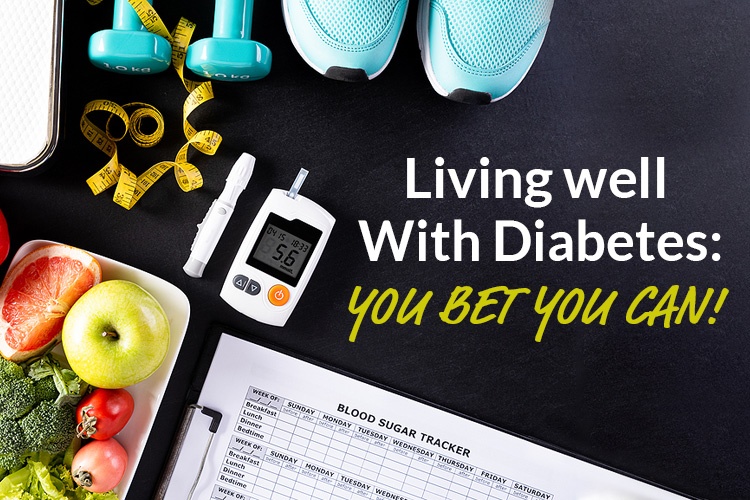Yesterday, I had a 3 month check up for my diabetes. Besides blood pressure (good), weight (I’ve lost 7 pounds since I was last weighed!), and my blood sugars (almost always “high”, but there’s a chance I might just have something called “hyperglycemia”. I’ll deal with that later! (Not medically, as a blog post!)
Today, I want to delve more into what exactly my A1c IS.
We’ll start with the “official” definition (aka Wikipedia): “Glycated hemoglobin (HbA1c, glycohemoglobin, hemoglobin, A1C or A1c) is a form of hemoglobin (Hb) that is chemically linked to a sugar. Most monosaccharides, including glucose, galactose and fructose, spontaneously (i.e. non-enzymatically) bond with hemoglobin when present in the bloodstream. However, glucose is less likely to do so than galactose and fructose (13% that of fructose and 21% that of galactose), which may explain why glucose is used as the primary metabolic fuel in humans.”
OK – that’s not terribly helpful. How about someone else? The site EVERYDAY HEALTH, puts it this way: “[The A1c] measures your average blood sugar level over the past three months. Called hemoglobin A1C, or A1C, this test can show you how well your type 2 diabetes management plan is working.”
That seems pretty clear, but HOW does it measure my average blood sugar level? It’s one blood draw! How can it tell how my blood sugars have been for the past THREE MONTHS???
“‘Glycation’ of [many] proteins happens often. When blood glucose levels are high, the glucose attaches to the hemoglobin in red blood cells. When there’s too much glucose in the blood, the more glucose hooks on to hemoglobin in the red blood cells and the higher the glycated hemoglobin.
“Once this happens, it stays that way. When there’s a more than usual amount of this in the red cell, it shows that the cell has been exposed to too much glucose during its life-cycle. A1c is an average of glucose levels during the life of the red blood cells.”
OK. I get how this happens now! But so what? So what if there’s too much glucose attached to the red blood cells in my body? Banner Health has this to say, “High A1c levels mean your diabetes isn’t controlled very well. That can increase your risk for complications, so you may need to be screened for kidney damage, nerve damage, eye damage, and heart disease. Additionally, according to the American Diabetes Association, diabetes is the seventh-leading cause of death in the United States. “It’s worth mentioning that the top six causes of death are all influenced and/or worsened by diabetes, too,” Dr. Bridenstine said.
So what can I do? A1c levels improved significantly after 20 days from start or intensification of glucose-lowering treatment. What are some of those glucose-lowering treatments? We’ll start with natural ways to lower your A1c.
1) Probiotics CAN make a significant reduction in glycated hemoglobin in type 2 diabetics. What are probiotics? Yogurt (avoid ones that are LOADED with sugar! That tradeoff isn’t a good one! Us can sweeten your yogurt with fruit. Unsweetened applesauce is an effective “mixer” for plain yogurt.) Other probiotics (check the labels o make sure the culture is still active/alive!) Different varieties of cheese, kefir, sourdough bread, kimchi, and kombucha. Check the computer for others!
2) Entertain the idea of low carb/high protein meals. Things like lean meats or fish paired with vegetables NOT like peas, beans, carrots, corn, and potatoes. It’s NOT that you CAN’T have them, but you can’t binge on baked potatoes/sweet potatoes and sour cream/maple syrup! By the way, “French fries are NOT potatoes! They are FORMERLY potatoes drowned in boiling oil (used to be an execution sentence! Oh, wait, it is for potatoes. Kills any good the potato had to start with).
3) Water. It’s your friend. Even if you hate it. People my age and my dad’s age didn’t drink water unless they had to. We’d buy Dad a case of bottled water and it would stay unopened for months at a time. I force myself to drink a 1 liter bottle of water (minimal) plus sodas and coffee. Sometimes I drink more water. USUALLY not less.
4) Try to love salads. My wife does NOT. I happen to. HOWEVER, avoid the urge to drown your salad in creamy dressings, then sprinkling with raisins, crumbled taco chips, crushed candied peanuts and walnuts…those are NOT salad! Also, try this: instead of dumping the bag of dressing (or a quarter of a bottle) on your bagged salads, put it in a container and DIP THE FORK into the dressing, then spear your mouthful of lettuce ands… It cuts down on the amount of high calorie, non-food dressings you end up eating, and you might actually taste the mix of lettuce and veggies! Also, try eating different mixes of salads – the grocery store makes it convenient.
5) Exercise. Yeah, I know, me, too: HATE to exercise. I use a trainer for my bike during the Minnesota Winter (usually 4-6 months of snow. Currently, I stopped outdoor biking on November 7, 2022. I started riding again last week on March 27, 2023. (five months of trainer-ing.) BUT, I also did thirteen squats before getting on the trainer (every other day); I also spent a few moments on a balancing disk. I also set up my trainer so I can read while pedaling.
So, the prescription is probiotics, low carb/high protein meals, water, salads/veggies, exercise. I haven’t gotten my most recent A1c back yet, but I’ll add it in when I do!
Source: https://www.dignityhealth.org/articles/7-ways-to-lower-your-a1c-level-even-if-you-dont-have-diabetes, https://www.bannerhealth.com/healthcareblog/teach-me/why-a1c-is-so-significant, https://8fit.com/nutrition/high-carb-vegetables-your-comprehensive-guide/
Image: https://www.hcd.com/wp-content/uploads/2021/01/living-well-with-diabetes.jpg

No comments:
Post a Comment